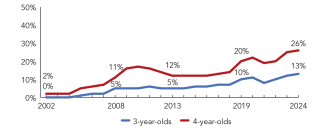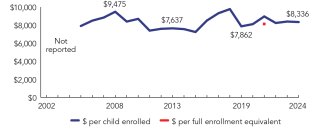
State of Preschool
Pennsylvania
Access Rankings
Resource Rankings
Total Benchmarks Met
Overview

During the 2023-2024 school year, Pennsylvania preschool enrolled 55,183 children, an increase of 2,221 from the prior year. State spending totaled $460,009,750, up $15,601,907 (4%), adjusted for inflation, since last year. State spending per child equaled $8,336 in 2023-2024, down $55 from 2022-2023, adjusted for inflation. Pennsylvania met 6.7 of 10 quality standards benchmarks.
What's New

PA Pre-K Counts (PAPKC) began its competitive 5-year-cycle rebid process in 2023-2024. All PAPKC grantees had to reapply, and new applicants were also accepted. There was a considerable budget impasse which delayed contracts and funding. New student enrollment reporting requirements were added. Beginning in the 2024-2025 school year, additional funding was allocated to increase the child-per spending amount from $10,000 to $10,500 (for PAPKC fulltime slots) and the Head Start Supplemental Assistance Program (PAHSSAP) grantees received a 3.01% cost per child increase. PAHSSAP also began implementing the revised Head Start performance standards.
Background
The PDE oversees and conducts fiscal monitoring for four pre-kindergarten programs: PA Ready to Learn Block Grant (RTL), PA Head Start Supplemental Assistance Program (PAHSSAP), PA Kindergarten for Four-Year-Olds and School Based Pre-K (K4 and SBPK), and PA Pre-K Counts (PAPKC).
RTL (formerly known as the Education Accountability Block Grant Program) was launched in 2004 and is funded through the school aid formula with 75% of funds targeted to children who have not achieved proficiency on the PA System for School Assessment test. School districts may opt to offer this program or choose from a list of other services.
PAHSSAP, launched in 2004 provides extended-day services for children attending federally funded Head Start programs, as well as additional Head Start slots. Programs must meet federal Head Start Performance Standards and programs in child care centers must participate in the Pennsylvania quality rating and improvement system (QRIS). PAHSSAP programs are required to use CLASS, ECERS, or another locally selected tool to annually conduct structured observations of classroom quality. The program is monitored and administered by the Office of Child Development and Early Learning (OCDEL), which is accountable to the Pennsylvania Departments of Education and Human Services.
K4 and SBPK, the longest running of the state’s pre-K programs, are financed through the state’s general fund. K4 launched in the 1990s as “kindergarten for 4-year-olds” and funding is now available to any districts wishing to offer the programs, but enrollment is low. Policy decisions are decentralized to the local school district level.
PAPKC enrolls the most children of the four state pre-K programs and operates in most school districts statewide. The PAPKC program operated in 98% of the state’s 500 school districts during the 2023-2024 school year. Launched in 2007, specifically to expand access to high quality pre-K, programs can enroll children up to two years before they are eligible for kindergarten. Children living in households with incomes up to 300% FPL are eligible for PAPKC. A variety of programs — Head Start, child care, licensed private academic schools and public school districts — are eligible to apply for funding awarded through competitive grants every five years. Site monitoring is conducted annually by program specialists and programs are required to have an annual assessment of the learning environment, which may include self-assessments.
-
Access

Total state pre-K enrollment 55,183 Special education enrollment, ages 3 and 4 28,663 Federally funded Head Start enrollment, ages 3 and 4 18,408 State-funded Head Start enrollment, ages 3 and 4 6,984 Resources
Total state pre-K spending $460,009,750 State Head Start spending $88,175,472 State spending per child enrolled $8,336 All reported spending per child enrolled* $8,336 
*Pre-K programs may receive additional funds from federal or local sources that are not included in this figure. †Head Start per-child spending includes funding only for 3- and 4-year-olds. ‡K–12 expenditures include capital spending as well as current operating expenditures.
-
Access
Resources
Total state pre-K spending $16,358,963 Local match required? No State spending per child enrolled $2,190 All reported spending per child enrolled* $2,190 
*Pre-K programs may receive additional funds from federal or local sources that are not included in this figure. †Head Start per-child spending includes funding only for 3- and 4-year-olds. ‡K–12 expenditures include capital spending as well as current operating expenditures.
Pennsylvania Ready to Learn Block Grant Quality Standards Checklist
| Policy | PA EABG/RTL Requirement | Benchmark | Meets Benchmark? |
|---|---|---|---|
For more information about the benchmarks, see the Executive Summary and the Roadmap to State pages. | 5benchmarks met | ||
| Early Learning & Development Standards Benchmark | Comprehensive, aligned, supported, culturally sensitive | Comprehensive, aligned, supported, culturally sensitive | |
| Curriculum Supports Benchmark | Approval process & supports | Approval process & supports | |
| Teacher Degree Benchmark | BA (public); AA (nonpublic) | BA | |
| Teacher Specialized Training Benchmark | PK-4, B-3 (public); ECE (nonpublic) | Specializing in pre-K | |
| Assistant Teacher Degree Benchmark | Other | CDA or equivalent | |
| Staff Professional Development Benchmark | 180 hours/5 years (teachers only); PD plans (new public teachers); Coaching (new public teachers) | For teachers & assistants: At least 15 hours/year; individual PD plans; coaching | |
| Maximum Class Size Benchmark | 20 (3- & 4-year-olds) | 20 or lower | |
| Staff to Child Ratio Benchmark | 1:10 (3- & 4-year-olds) | 1:10 or better | |
| Screening & Referral Benchmark | Determined locally | Vision, hearing & health screenings; & referral | |
| Continuous Quality Improvement System Benchmark | Observations required for Instructional I certified teachers only; Data used for program improvement | Structured classroom observations; data used for program improvement | |
-
Access
Resources
Total state pre-K spending $88,175,472 Local match required? No State spending per child enrolled $12,625 All reported spending per child enrolled* $12,625 
*Pre-K programs may receive additional funds from federal or local sources that are not included in this figure. †Head Start per-child spending includes funding only for 3- and 4-year-olds. ‡K–12 expenditures include capital spending as well as current operating expenditures.
Pennsylvania Head Start Supplemental Assistance Program Quality Standards Checklist
| Policy | PA HSSAP Requirement | Benchmark | Meets Benchmark? |
|---|---|---|---|
For more information about the benchmarks, see the Executive Summary and the Roadmap to State pages. | 8benchmarks met | ||
| Early Learning & Development Standards Benchmark | Comprehensive, aligned, supported, culturally sensitive | Comprehensive, aligned, supported, culturally sensitive | |
| Curriculum Supports Benchmark | Approval process & supports | Approval process & supports | |
| Teacher Degree Benchmark | AA | BA | |
| Teacher Specialized Training Benchmark | ECE, CD | Specializing in pre-K | |
| Assistant Teacher Degree Benchmark | CDA | CDA or equivalent | |
| Staff Professional Development Benchmark | 15 hours/year; PD plans; Coaching | For teachers & assistants: At least 15 hours/year; individual PD plans; coaching | |
| Maximum Class Size Benchmark | 20 (3- & 4-year-olds) | 20 or lower | |
| Staff to Child Ratio Benchmark | 1:10 (3- & 4-year-olds) | 1:10 or better | |
| Screening & Referral Benchmark | Vision, hearing, health & more | Vision, hearing & health screenings; & referral | |
| Continuous Quality Improvement System Benchmark | Structured classroom observations; Data used for program improvement at local level only | Structured classroom observations; data used for program improvement | |
-
Access
Resources
Total state pre-K spending $51,152,630 Local match required? No State spending per child enrolled $5,204 All reported spending per child enrolled* $5,204 
*Pre-K programs may receive additional funds from federal or local sources that are not included in this figure. †Head Start per-child spending includes funding only for 3- and 4-year-olds. ‡K–12 expenditures include capital spending as well as current operating expenditures.
Pennsylvania Kindergarten for Four-Year-Olds and School-Based Pre-K Quality Standards Checklist
| Policy | PA K4/SBPK Requirement | Benchmark | Meets Benchmark? |
|---|---|---|---|
For more information about the benchmarks, see the Executive Summary and the Roadmap to State pages. | 3benchmarks met | ||
| Early Learning & Development Standards Benchmark | Comprehensive, aligned, supported, culturally sensitive | Comprehensive, aligned, supported, culturally sensitive | |
| Curriculum Supports Benchmark | Approval process & supports | Approval process & supports | |
| Teacher Degree Benchmark | BA (public); AA (nonpublic) | BA | |
| Teacher Specialized Training Benchmark | PK-4, B-3, K-6 (public); PK-4, B-3 (nonpublic) | Specializing in pre-K | |
| Assistant Teacher Degree Benchmark | Other | CDA or equivalent | |
| Staff Professional Development Benchmark | 180 hours/5 years (SBPK public teachers only); PD plan (new public teachers & some nonpublic teachers & assistants); Coaching (new public teachers & some nonpublic teachers & assistants) | For teachers & assistants: At least 15 hours/year; individual PD plans; coaching | |
| Maximum Class Size Benchmark | SBPK: 20 (3- & 4-year-olds); K4: No limit | 20 or lower | |
| Staff to Child Ratio Benchmark | SBPK: 1:10 (3- & 4-year-olds); K4: No limit | 1:10 or better | |
| Screening & Referral Benchmark | Vision, hearing, health & more | Vision, hearing & health screenings; & referral | |
| Continuous Quality Improvement System Benchmark | Observations required for Instructional I certified teachers only; Data used for program improvement | Structured classroom observations; data used for program improvement | |
-
Access

Total state pre-K enrollment 30,898 School districts that offer state program 98% Income requirement 300% FPL Minimum hours of operation 2.5 hours/day; 5 days/week Operating schedule School or academic year Resources
Total state pre-K spending $304,322,685 Local match required? No State spending per child enrolled $9,849 All reported spending per child enrolled* $9,849 
*Pre-K programs may receive additional funds from federal or local sources that are not included in this figure. †Head Start per-child spending includes funding only for 3- and 4-year-olds. ‡K–12 expenditures include capital spending as well as current operating expenditures.
Pennsylvania Pre-K Counts Quality Standards Checklist
| Policy | PA Pre-K Counts Requirement | Benchmark | Meets Benchmark? |
|---|---|---|---|
For more information about the benchmarks, see the Executive Summary and the Roadmap to State pages. | 8*benchmarks met | ||
| Early Learning & Development Standards Benchmark | Comprehensive, aligned, supported, culturally sensitive | Comprehensive, aligned, supported, culturally sensitive | |
| Curriculum Supports Benchmark | Approval process & supports | Approval process & supports | |
| Teacher Degree Benchmark | BA* | BA | |
| Teacher Specialized Training Benchmark | PK-4, B-3 | Specializing in pre-K | |
| Assistant Teacher Degree Benchmark | Other | CDA or equivalent | |
| Staff Professional Development Benchmark | 180 hours/5 years (teachers); 24 hours/year (assistants) PD plans (some teachers & assistants); Coaching (new teachers) | For teachers & assistants: At least 15 hours/year; individual PD plans; coaching | |
| Maximum Class Size Benchmark | 20 (3- & 4-year-olds) | 20 or lower | |
| Staff to Child Ratio Benchmark | 1:10 (3- & 4-year-olds) | 1:10 or better | |
| Screening & Referral Benchmark | Vision, hearing, health & more | Vision, hearing & health screenings; & referral | |
| Continuous Quality Improvement System Benchmark | Structured classroom observations; Data used for program improvement | Structured classroom observations; data used for program improvement | |
* Indicates that while policy meets the benchmark, it is not being implemented fully